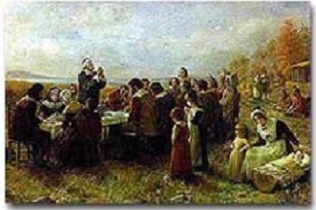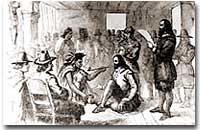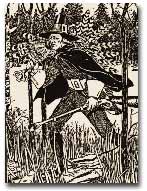You've recently arrived on the shores of this land, not where you thought you would..You're not gonna make it without some help.
Over half of you have died already.
You pray to your God for help.
A Native American walks out of the woods and asks in clear King's English:
"Can I help?", and proceeds to show you how to farm, fish, hunt, survive and serves as an ambassador to the native people.
Yea, there's a God, and He had a hand in founding this country.
Focus on the Family did a radio drama on it:
Share it with your kids.
Squanto Story pt 1
Squanto Story pt 2
Or if you want to read about him instead.
Happy Thanksgiving.
If you read about Bradford below, which I of course recommend, Understand that they almost died because of a socialist philosophy. Bradford put an end to that, and they all prospered.
(I am truly thankful today that I could rip this off from http://www.ushistory.org/us/3b.asp )
William Bradford and the First Thanksgiving

Copyright 2001 by Pilgrim Hall Museum
As was the custom in England, the Pilgrims celebrated their harvest with a festival. The 50 remaining colonists and roughly 90 Wampanoag tribesmen attended the "First Thanksgiving."
The major similarity between the first Jamestown settlers and the first Plymouth settlers was great human suffering.
November was too late to plant crops. Many settlers died of scurvy and malnutrition during that horrible first winter. Of the 102 original Mayflower passengers, only 44 survived. Again like in Jamestown, the kindness of the local Native Americans saved them from a frosty death.
The Pilgrims' remarkable courage was displayed the following spring. When the Mayflower returned to Europe, not a single Pilgrim deserted Plymouth.
Helping Hands

Massasoit, chief of the Wampanoag tribe, signed a treaty with the Pilgrams in 1621, that was never broken. As a result, the two groups enjoyed a peaceful coexistence.
By early 1621, the Pilgrims had built crude huts and a common house on the shores of Plymouth Bay. Soon neighboring Indians began to build relations with the Pilgrims. SQUANTO, a local Indian who had been kidnapped and taken to England nearly a decade before, served as an interpreter with the local tribes. Squanto taught the Pilgrims to fertilize the soil with dried fish remains to produce a stellar corn crop.
MASSASOIT, the chief of the nearby Wampanoags, signed a treaty of alliance with the Pilgrims in the summer. In exchange for assistance with defense against the feared Narragansett tribe, Massasoit supplemented the food supply of the Pilgrims for the first few years.
Governor Bradford

The modern conception of a Pilgrim might include a man in a black hat with a buckle, but not all of the original settlers of Plymouth County fit this description.
Successful colonies require successful leadership. The man to step forward in Plymouth colony was WILLIAM BRADFORD. After the first governor elected under the Mayflower Compact perished from the harsh winter, Bradford was elected governor for the next thirty years. In May of 1621, he performed the colony's first marriage ceremony.
Under Bradford's guidance, Plymouth suffered less hardship than their English compatriots in Virginia. Relations with the local natives remained relatively smooth in Plymouth and the food supply grew with each passing year.
By autumn of 1621, the Pilgrims had much for which to be thankful. After the harvest, Massasoit and about ninety other Indians joined the Pilgrims for the great English tradition of HARVEST FESTIVAL. The participants celebrated for several days, dining on venison, goose, duck, turkey, fish, and of course, cornbread, the result of a bountiful corn harvest. This tradition was repeated at harvest time in the following years.
It was President Lincoln who declared Thanksgiving a national celebration in 1863. The Plymouth Pilgrims simply celebrated survival, as well as the hopes of good fortune in the years that lay ahead.
In England the word corn refers to wheat. What Americans call corn the Brits call maize.
ReplyDeleteSo I have to ask: what was this cornbread made of? Maize was a produce of found in Mexico and carried back to Europe sometime in the 1500s. So this could have been maize, kernels of which came over with the Pilgrims. I don't know yet which "corn" this is. It could be maize or it could be wheat.
Gotta check the original Greek.
DeleteOh wait. That's not gonna work.
Was wheat bread ever referred to as cornbread?
DeleteOr other than just "bread"?
I did not know that about England. Thanks for the information. No wonder my British wife doesn't like maize-pone.
DeleteHappy Thanksgiving Ed.... wishing you a wonderful day.... :)
ReplyDeleteThank You! And the same to you and yous.
DeleteMay God's blessings overwhelm you. :)
My best to you and yours on this Thanksgiving Day. When I reflect upon my many blessings, Ed ... you are one.
ReplyDeleteIt is my great blessing to know you Mustang.
DeleteEnjoy this day!
And you and your, Joe
ReplyDeleteHave a great warm, good company and food filled day Ed.
ReplyDeleteThank you Kid!
DeleteSame to you!